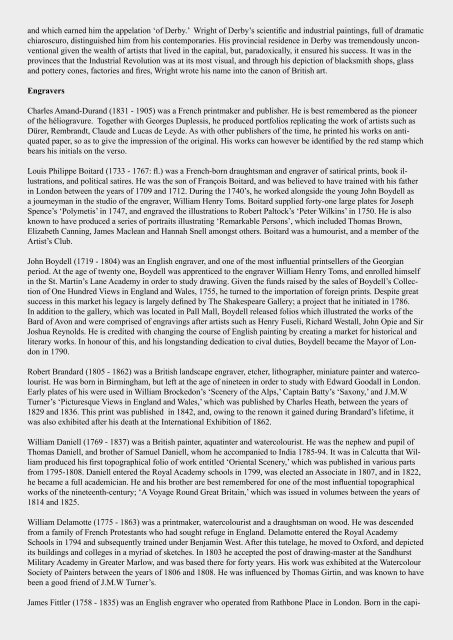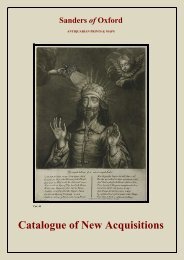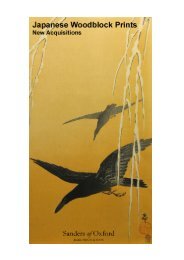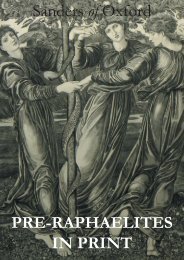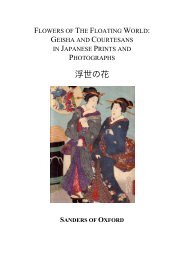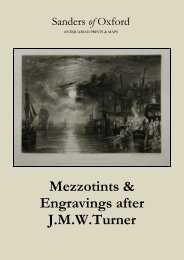catalogue text.indd - Sanders of Oxford
catalogue text.indd - Sanders of Oxford
catalogue text.indd - Sanders of Oxford
You also want an ePaper? Increase the reach of your titles
YUMPU automatically turns print PDFs into web optimized ePapers that Google loves.
and which earned him the appelation ‘<strong>of</strong> Derby.’ Wright <strong>of</strong> Derby’s scientific and industrial paintings, full <strong>of</strong> dramatic<br />
chiaroscuro, distinguished him from his contemporaries. His provincial residence in Derby was tremendously unconventional<br />
given the wealth <strong>of</strong> artists that lived in the capital, but, paradoxically, it ensured his success. It was in the<br />
provinces that the Industrial Revolution was at its most visual, and through his depiction <strong>of</strong> blacksmith shops, glass<br />
and pottery cones, factories and fires, Wright wrote his name into the canon <strong>of</strong> British art.<br />
Engravers<br />
Charles Amand-Durand (1831 - 1905) was a French printmaker and publisher. He is best remembered as the pioneer<br />
<strong>of</strong> the héliogravure. Together with Georges Duplessis, he produced portfolios replicating the work <strong>of</strong> artists such as<br />
Dürer, Rembrandt, Claude and Lucas de Leyde. As with other publishers <strong>of</strong> the time, he printed his works on antiquated<br />
paper, so as to give the impression <strong>of</strong> the original. His works can however be identified by the red stamp which<br />
bears his initials on the verso.<br />
Louis Philippe Boitard (1733 - 1767: fl.) was a French-born draughtsman and engraver <strong>of</strong> satirical prints, book illustrations,<br />
and political satires. He was the son <strong>of</strong> François Boitard, and was believed to have trained with his father<br />
in London between the years <strong>of</strong> 1709 and 1712. During the 1740’s, he worked alongside the young John Boydell as<br />
a journeyman in the studio <strong>of</strong> the engraver, William Henry Toms. Boitard supplied forty-one large plates for Joseph<br />
Spence’s ‘Polymetis’ in 1747, and engraved the illustrations to Robert Paltock’s ‘Peter Wilkins’ in 1750. He is also<br />
known to have produced a series <strong>of</strong> portraits illustrating ‘Remarkable Persons’, which included Thomas Brown,<br />
Elizabeth Canning, James Maclean and Hannah Snell amongst others. Boitard was a humourist, and a member <strong>of</strong> the<br />
Artist’s Club.<br />
John Boydell (1719 - 1804) was an English engraver, and one <strong>of</strong> the most influential printsellers <strong>of</strong> the Georgian<br />
period. At the age <strong>of</strong> twenty one, Boydell was apprenticed to the engraver William Henry Toms, and enrolled himself<br />
in the St. Martin’s Lane Academy in order to study drawing. Given the funds raised by the sales <strong>of</strong> Boydell’s Collection<br />
<strong>of</strong> One Hundred Views in England and Wales, 1755, he turned to the importation <strong>of</strong> foreign prints. Despite great<br />
success in this market his legacy is largely defined by The Shakespeare Gallery; a project that he initiated in 1786.<br />
In addition to the gallery, which was located in Pall Mall, Boydell released folios which illustrated the works <strong>of</strong> the<br />
Bard <strong>of</strong> Avon and were comprised <strong>of</strong> engravings after artists such as Henry Fuseli, Richard Westall, John Opie and Sir<br />
Joshua Reynolds. He is credited with changing the course <strong>of</strong> English painting by creating a market for historical and<br />
literary works. In honour <strong>of</strong> this, and his longstanding dedication to cival duties, Boydell became the Mayor <strong>of</strong> London<br />
in 1790.<br />
Robert Brandard (1805 - 1862) was a British landscape engraver, etcher, lithographer, miniature painter and watercolourist.<br />
He was born in Birmingham, but left at the age <strong>of</strong> nineteen in order to study with Edward Goodall in London.<br />
Early plates <strong>of</strong> his were used in William Brockedon’s ‘Scenery <strong>of</strong> the Alps,’ Captain Batty’s ‘Saxony,’ and J.M.W<br />
Turner’s ‘Picturesque Views in England and Wales,’ which was published by Charles Heath, between the years <strong>of</strong><br />
1829 and 1836. This print was published in 1842, and, owing to the renown it gained during Brandard’s lifetime, it<br />
was also exhibited after his death at the International Exhibition <strong>of</strong> 1862.<br />
William Daniell (1769 - 1837) was a British painter, aquatinter and watercolourist. He was the nephew and pupil <strong>of</strong><br />
Thomas Daniell, and brother <strong>of</strong> Samuel Daniell, whom he accompanied to India 1785-94. It was in Calcutta that William<br />
produced his first topographical folio <strong>of</strong> work entitled ‘Oriental Scenery,’ which was published in various parts<br />
from 1795-1808. Daniell entered the Royal Academy schools in 1799, was elected an Associate in 1807, and in 1822,<br />
he became a full academician. He and his brother are best remembered for one <strong>of</strong> the most influential topographical<br />
works <strong>of</strong> the nineteenth-century; ‘A Voyage Round Great Britain,’ which was issued in volumes between the years <strong>of</strong><br />
1814 and 1825.<br />
William Delamotte (1775 - 1863) was a printmaker, watercolourist and a draughtsman on wood. He was descended<br />
from a family <strong>of</strong> French Protestants who had sought refuge in England. Delamotte entered the Royal Academy<br />
Schools in 1794 and subsequently trained under Benjamin West. After this tutelage, he moved to <strong>Oxford</strong>, and depicted<br />
its buildings and colleges in a myriad <strong>of</strong> sketches. In 1803 he accepted the post <strong>of</strong> drawing-master at the Sandhurst<br />
Military Academy in Greater Marlow, and was based there for forty years. His work was exhibited at the Watercolour<br />
Society <strong>of</strong> Painters between the years <strong>of</strong> 1806 and 1808. He was influenced by Thomas Girtin, and was known to have<br />
been a good friend <strong>of</strong> J.M.W Turner’s.<br />
James Fittler (1758 - 1835) was an English engraver who operated from Rathbone Place in London. Born in the capi-


